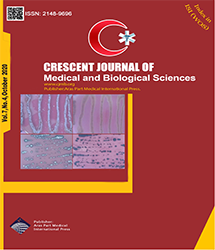
| Review | |
| A New Treatment Method in Hepatocellular Carcinoma by MicroRNAs | |
| Zahra Asefy1,2,3,4, Behrooz Shokuhi1, Alireza Abhari2, Zeinab Latifi2, Saeed Nazari Soltan Ahmad2, Naser Samadi2, Sirus Hoseinnejhad4, Asgar Tanomand4, Mohammad Nouri1,2 | |
| 1Liver and Gastrointestinal Diseases Research Center, Tabriz University of Medical Sciences, Tabriz, Iran 2Department of Biochemistry and Clinical Laboratories, Tabriz University of Medical Sciences, Tabriz, Iran 3Student’s Research Committee, Tabriz University of Medical Sciences, Tabriz, Iran 4Maragheh University of Medical Sciences Maragheh, Iran |
|
|
CJMB 2020; 7: 451-456 Viewed : 3897 times Downloaded : 3126 times. Keywords : Hepatocellular carcinoma, miRNA, Molecular targets |
|
| Full Text(PDF) | Related Articles | |
| Abstract | |
Objectives: Hepatocellular carcinoma (HCC) is considered as the most incidence form of cancer in the human liver and the main reason for worldwide cancer death. In addition, HCC is a common form of cancer in Africa and Asia and a global health issue. Thus, efforts should be made to improve treatment strategies and prognosis in HCC for recognizing novel prognostic and predictive markers. Methods: The present study reviewed recently published studies that were identified from the National Institutes of Health"s PubMed database, Latin American Literature in Health Sciences, and Scientific Electronic Library Online. To this end, several key terms were searched, including "hepatocellular carcinoma" AND "diagnosis" AND "hepatic resection", miRNA, and Mesh (Medical Subject Headings) consisting of miRNA "hepatocellular carcinoma". Results: Both physiological and pathological processes such as development can be altered by the function and expression modifying of miRNA. The findings revealed that miR-101, miR-106, miR-130a, miR-515-5p, miR-199a, and miR-34a-5p have a considerable connection with tumor size in HCC patients. Conclusions: In general, several reports indicated that more than half of the miRNAs genes are located in cancer-associated genomic regions or fragile sites. Considering the reports regarding the important roles of miRNAs in cancer, their potential as prognostic or diagnostics markers is confirmed by a long list of studies and miRNA markers that could be used for cancer diagnosis are becoming available |
Cite By, Google Scholar
Google Scholar
PubMed
Online Submission System
 CJMB ENDNOTE ® Style
CJMB ENDNOTE ® Style
 Tutorials
Tutorials
 Publication Charge
Medical and Biological Research Center
About Journal
Publication Charge
Medical and Biological Research Center
About Journal
Aras Part Medical International Press Editor-in-Chief
Arash Khaki
Deputy Editor
Zafer Akan


















